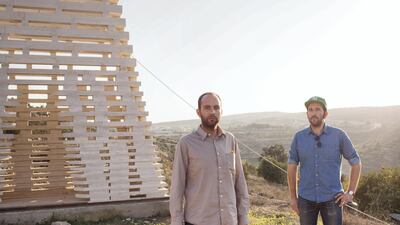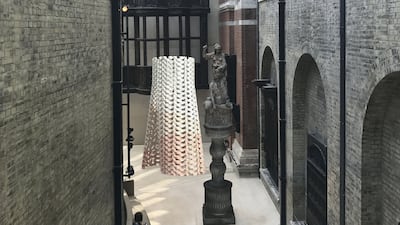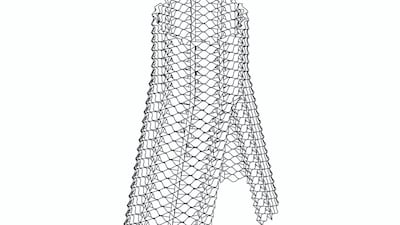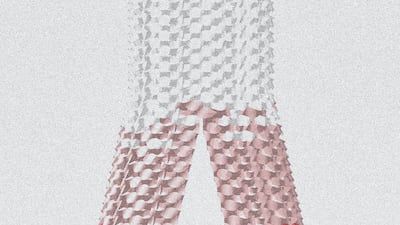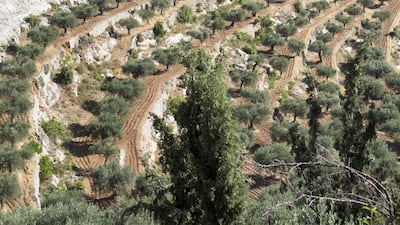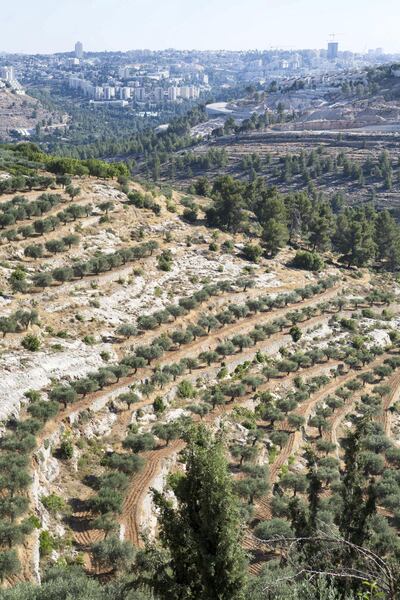The latest project from AAU ANASTAS combines the latest digital fabrication techniques with the traditional materials of Elias and Yousef Anastas's native Palestine.
Following the success of their experimental vault, Stone Matters, which was exhibited in Jericho earlier this year and The Stonesourcing Space, which was exhibited in Bethlehem in 2012, While We Wait is the latest pavilion from the Paris and Bethlehem-based architectural team.
The chimney-shaped structure has been commissioned by the Victoria & Albert Museum for the 2017 London Design Festival and will be exhibited in the museum's Simon Sainsbury Gallery from 16-24 September and after that it will travel to Dubai where it will be exhibited at Alserkal Avenue's OMA-designed exhibition space, Concrete, between November 6-18.
“We are very excited to have commissioned Elias and Yousef Anastas for this edition of the London Design Festival at the V&A. Their ongoing work demonstrates a deep dedication and understanding of local traditions and innovation of technique," said the Middle East Curator in the V&A’s Asian Department, Salma Tuqan, in a statement.
"Their roving intervention stands as an ode to the natural landscape, and will resonate beyond its iterations in London and Dubai, eventually settling in the Cremisan Valley where it will become a space for collective meditation and gathering.”
"The vision behind Concrete has always been to create a multi-dimensional platform that is ideal for museum-grade exhibitions across the spectrum of art, performance and design," added Alserkal Avenue's founder, Abdelmonem Bin Eisa Alserkal, also in a written statement. "While We Wait inhabits the intersection of contemporary art and design while also being relevant to the diverse audiences in Dubai. We hope that this will be the first of many such collaborations."
Designed digitally, cut by robots, and finished by hand, While We Wait is composed of a large, lattice-like, self-supporting structure made from stone that has been quarried in various regions of Palestine, the structure is inspired by the traditional landscape and rocky terraces of the Cremisan Valley, near Bethlehem.
A place of ancient olive groves, vineyards and two Salesian Catholic monasteries and a convent school that was also earmarked as the site of a new section of the Israeli West Bank barrier, or separation wall, in 2006.
In a May 2013, in response to Israeli proposals for the erection of the barrier, Bishop Richard Pates, the chairman of the bishops' Committee on International Justice and Peace for the United States Conference of Catholic Bishops wrote a letter to the then US Secretary of State John Kerry in which he described the Cremisan Valley as a: "microcosm of a protracted pattern that has serious implications for the ongoing Israeli-Palestinian conflict," he added.
"As the wall moves and constricts more communities in the West Bank, the possibility of a future two-state resolution becomes less likely. Moving the wall and disassociating Palestinian families from their lands and livelihoods will incite more resentment against the State of Israel among residents of the West Bank, not less, increasing the frustrations that can lead to violence."
In 2015, local Christian landowners in the Cremisan Valley told an EU delegation that construction of the wall could ultimately force them to emigrate and "cleanse" the area of its Christian residents and when construction of the wall restarted in August 2015, an EU mission expressed its "deep concern" at the development.
The Cremisan Valley section of the wall is designed to separate the West Bank city of Beit Jala from the settlement of Har Gilo and the village of Walaja but critics claim its real purpose is to allow for the expansion of settlements.
__________________________
Read more:
Shifting Ground, Ramallah: art under occupation
If the walls could move - a Concrete setting for art
Architects of hope: rebuilding Gaza and imagining a Palestinian state
__________________________
The more serious side of specialty coffee
While the taste of beans and freshness of roast is paramount to the specialty coffee scene, so is sustainability and workers’ rights.
The bulk of genuine specialty coffee companies aim to improve on these elements in every stage of production via direct relationships with farmers. For instance, Mokha 1450 on Al Wasl Road strives to work predominantly with women-owned and -operated coffee organisations, including female farmers in the Sabree mountains of Yemen.
Because, as the boutique’s owner, Garfield Kerr, points out: “women represent over 90 per cent of the coffee value chain, but are woefully underrepresented in less than 10 per cent of ownership and management throughout the global coffee industry.”
One of the UAE’s largest suppliers of green (meaning not-yet-roasted) beans, Raw Coffee, is a founding member of the Partnership of Gender Equity, which aims to empower female coffee farmers and harvesters.
Also, globally, many companies have found the perfect way to recycle old coffee grounds: they create the perfect fertile soil in which to grow mushrooms.
Real estate tokenisation project
Dubai launched the pilot phase of its real estate tokenisation project last month.
The initiative focuses on converting real estate assets into digital tokens recorded on blockchain technology and helps in streamlining the process of buying, selling and investing, the Dubai Land Department said.
Dubai’s real estate tokenisation market is projected to reach Dh60 billion ($16.33 billion) by 2033, representing 7 per cent of the emirate’s total property transactions, according to the DLD.
How much sugar is in chocolate Easter eggs?
- The 169g Crunchie egg has 15.9g of sugar per 25g serving, working out at around 107g of sugar per egg
- The 190g Maltesers Teasers egg contains 58g of sugar per 100g for the egg and 19.6g of sugar in each of the two Teasers bars that come with it
- The 188g Smarties egg has 113g of sugar per egg and 22.8g in the tube of Smarties it contains
- The Milky Bar white chocolate Egg Hunt Pack contains eight eggs at 7.7g of sugar per egg
- The Cadbury Creme Egg contains 26g of sugar per 40g egg
COMPANY%20PROFILE
%3Cp%3E%3Cstrong%3ECompany%20name%3A%3C%2Fstrong%3E%20Revibe%20%0D%3Cbr%3E%3Cstrong%3EStarted%3A%3C%2Fstrong%3E%202022%0D%3Cbr%3E%3Cstrong%3EFounders%3A%3C%2Fstrong%3E%20Hamza%20Iraqui%20and%20Abdessamad%20Ben%20Zakour%20%0D%3Cbr%3E%3Cstrong%3EBased%3A%3C%2Fstrong%3E%20UAE%20%0D%3Cbr%3E%3Cstrong%3EIndustry%3A%3C%2Fstrong%3E%20Refurbished%20electronics%20%0D%3Cbr%3E%3Cstrong%3EFunds%20raised%20so%20far%3A%3C%2Fstrong%3E%20%2410m%20%0D%3Cbr%3E%3Cstrong%3EInvestors%3A%20%3C%2Fstrong%3EFlat6Labs%2C%20Resonance%20and%20various%20others%0D%3C%2Fp%3E%0A
Mercer, the investment consulting arm of US services company Marsh & McLennan, expects its wealth division to at least double its assets under management (AUM) in the Middle East as wealth in the region continues to grow despite economic headwinds, a company official said.
Mercer Wealth, which globally has $160 billion in AUM, plans to boost its AUM in the region to $2-$3bn in the next 2-3 years from the present $1bn, said Yasir AbuShaban, a Dubai-based principal with Mercer Wealth.
“Within the next two to three years, we are looking at reaching $2 to $3 billion as a conservative estimate and we do see an opportunity to do so,” said Mr AbuShaban.
Mercer does not directly make investments, but allocates clients’ money they have discretion to, to professional asset managers. They also provide advice to clients.
“We have buying power. We can negotiate on their (client’s) behalf with asset managers to provide them lower fees than they otherwise would have to get on their own,” he added.
Mercer Wealth’s clients include sovereign wealth funds, family offices, and insurance companies among others.
From its office in Dubai, Mercer also looks after Africa, India and Turkey, where they also see opportunity for growth.
Wealth creation in Middle East and Africa (MEA) grew 8.5 per cent to $8.1 trillion last year from $7.5tn in 2015, higher than last year’s global average of 6 per cent and the second-highest growth in a region after Asia-Pacific which grew 9.9 per cent, according to consultancy Boston Consulting Group (BCG). In the region, where wealth grew just 1.9 per cent in 2015 compared with 2014, a pickup in oil prices has helped in wealth generation.
BCG is forecasting MEA wealth will rise to $12tn by 2021, growing at an annual average of 8 per cent.
Drivers of wealth generation in the region will be split evenly between new wealth creation and growth of performance of existing assets, according to BCG.
Another general trend in the region is clients’ looking for a comprehensive approach to investing, according to Mr AbuShaban.
“Institutional investors or some of the families are seeing a slowdown in the available capital they have to invest and in that sense they are looking at optimizing the way they manage their portfolios and making sure they are not investing haphazardly and different parts of their investment are working together,” said Mr AbuShaban.
Some clients also have a higher appetite for risk, given the low interest-rate environment that does not provide enough yield for some institutional investors. These clients are keen to invest in illiquid assets, such as private equity and infrastructure.
“What we have seen is a desire for higher returns in what has been a low-return environment specifically in various fixed income or bonds,” he said.
“In this environment, we have seen a de facto increase in the risk that clients are taking in things like illiquid investments, private equity investments, infrastructure and private debt, those kind of investments were higher illiquidity results in incrementally higher returns.”
The Abu Dhabi Investment Authority, one of the largest sovereign wealth funds, said in its 2016 report that has gradually increased its exposure in direct private equity and private credit transactions, mainly in Asian markets and especially in China and India. The authority’s private equity department focused on structured equities owing to “their defensive characteristics.”
Tell Me Who I Am
Director: Ed Perkins
Stars: Alex and Marcus Lewis
Four stars
Stage results
1. Julian Alaphilippe (FRA) Deceuninck-QuickStep 4:39:05
2. Michael Matthews (AUS) Team BikeExchange 0:00:08
3. Primoz Roglic (SLV) Jumbo-Visma same time
4. Jack Haig (AUS) Bahrain Victorious s.t
5. Wilco Kelderman (NED) Bora-Hansgrohe s.t
6. Tadej Pogacar (SLV) UAE Team Emirates s.t
7. David Gaudu (FRA) Groupama-FDJ s.t
8. Sergio Higuita Garcia (COL) EF Education-Nippo s.t
9. Bauke Mollema (NED) Trek-Segafredo s.t
10. Geraint Thomas (GBR) Ineos Grenadiers s.t
Results
%3Cp%3E%0D%3Cstrong%3EElite%20men%3C%2Fstrong%3E%0D%3Cbr%3E1.%20Amare%20Hailemichael%20Samson%20(ERI)%202%3A07%3A10%0D%3Cbr%3E2.%20Leornard%20Barsoton%20(KEN)%202%3A09%3A37%0D%3Cbr%3E3.%20Ilham%20Ozbilan%20(TUR)%202%3A10%3A16%0D%3Cbr%3E4.%20Gideon%20Chepkonga%20(KEN)%202%3A11%3A17%0D%3Cbr%3E5.%20Isaac%20Timoi%20(KEN)%202%3A11%3A34%0D%3Cbr%3E%3Cstrong%3EElite%20women%3C%2Fstrong%3E%0D%3Cbr%3E1.%20Brigid%20Kosgei%20(KEN)%202%3A19%3A15%0D%3Cbr%3E2.%20Hawi%20Feysa%20Gejia%20(ETH)%202%3A24%3A03%0D%3Cbr%3E3.%20Sintayehu%20Dessi%20(ETH)%202%3A25%3A36%0D%3Cbr%3E4.%20Aurelia%20Kiptui%20(KEN)%202%3A28%3A59%0D%3Cbr%3E5.%20Emily%20Kipchumba%20(KEN)%202%3A29%3A52%3C%2Fp%3E%0A
The%20Iron%20Claw
%3Cp%3E%3Cstrong%3EDirector%3A%3C%2Fstrong%3E%20Sean%20Durkin%C2%A0%3C%2Fp%3E%0A%3Cp%3E%3Cstrong%3EStarring%3A%3C%2Fstrong%3E%20Zac%20Efron%2C%20Jeremy%20Allen%20White%2C%20Harris%20Dickinson%2C%20Maura%20Tierney%2C%20Holt%20McCallany%2C%20Lily%20James%3C%2Fp%3E%0A%3Cp%3E%3Cstrong%3ERating%3A%3C%2Fstrong%3E%204%2F5%3C%2Fp%3E%0A
Brief scoreline
Switzerland 0
England 0
Result: England win 6-5 on penalties
Man of the Match: Trent Alexander-Arnold (England)
What's in the deal?
Agreement aims to boost trade by £25.5bn a year in the long run, compared with a total of £42.6bn in 2024
India will slash levies on medical devices, machinery, cosmetics, soft drinks and lamb.
India will also cut automotive tariffs to 10% under a quota from over 100% currently.
Indian employees in the UK will receive three years exemption from social security payments
India expects 99% of exports to benefit from zero duty, raising opportunities for textiles, marine products, footwear and jewellery
Pari
Produced by: Clean Slate Films (Anushka Sharma, Karnesh Sharma) & KriArj Entertainment
Director: Prosit Roy
Starring: Anushka Sharma, Parambrata Chattopadhyay, Ritabhari Chakraborty, Rajat Kapoor, Mansi Multani
Three stars
Wicked: For Good
Director: Jon M Chu
Starring: Ariana Grande, Cynthia Erivo, Jonathan Bailey, Jeff Goldblum, Michelle Yeoh, Ethan Slater
Rating: 4/5
Veil (Object Lessons)
Rafia Zakaria
Bloomsbury Academic
The details
Heard It in a Past Life
Maggie Rogers
(Capital Records)
3/5
ABU DHABI ORDER OF PLAY
Starting at 10am:
Daria Kasatkina v Qiang Wang
Veronika Kudermetova v Annet Kontaveit (10)
Maria Sakkari (9) v Anastasia Potapova
Anastasia Pavlyuchenkova v Ons Jabeur (15)
Donna Vekic (16) v Bernarda Pera
Ekaterina Alexandrova v Zarina Diyas
COMPANY PROFILE
Name: Mamo Year it started: 2019 Founders: Imad Gharazeddine, Asim Janjua Based: Dubai, UAE Number of employees: 28 Sector: Financial services Investment: $9.5m Funding stage: Pre-Series A Investors: Global Ventures, GFC, 4DX Ventures, AlRajhi Partners, Olive Tree Capital, and prominent Silicon Valley investors. COMPANY%20PROFILE
%3Cp%3E%3Cstrong%3ECompany%20name%3A%3C%2Fstrong%3E%20Bedu%3C%2Fp%3E%0A%3Cp%3E%3Cstrong%3EStarted%3A%3C%2Fstrong%3E%202021%3C%2Fp%3E%0A%3Cp%3E%3Cstrong%3EFounders%3A%3C%2Fstrong%3E%20Khaled%20Al%20Huraimel%2C%20Matti%20Zinder%2C%20Amin%20Al%20Zarouni%3C%2Fp%3E%0A%3Cp%3E%3Cstrong%3EBased%3A%3C%2Fstrong%3E%20Dubai%2C%20UAE%3C%2Fp%3E%0A%3Cp%3E%3Cstrong%3EIndustry%3A%3C%2Fstrong%3E%20AI%2C%20metaverse%2C%20Web3%20and%20blockchain%3C%2Fp%3E%0A%3Cp%3E%3Cstrong%3EFunding%3A%3C%2Fstrong%3E%20Currently%20in%20pre-seed%20round%20to%20raise%20%245%20million%20to%20%247%20million%3C%2Fp%3E%0A%3Cp%3E%3Cstrong%3EInvestors%3A%3C%2Fstrong%3E%20Privately%20funded%3C%2Fp%3E%0A
COMPANY%20PROFILE
%3Cp%3E%3Cstrong%3ECompany%20name%3A%3C%2Fstrong%3E%20Klipit%3C%2Fp%3E%0A%3Cp%3E%3Cstrong%3EStarted%3A%3C%2Fstrong%3E%202022%3C%2Fp%3E%0A%3Cp%3E%3Cstrong%3EFounders%3A%3C%2Fstrong%3E%20Venkat%20Reddy%2C%20Mohammed%20Al%20Bulooki%2C%20Bilal%20Merchant%2C%20Asif%20Ahmed%2C%20Ovais%20Merchant%3C%2Fp%3E%0A%3Cp%3E%3Cstrong%3EBased%3A%3C%2Fstrong%3E%20Dubai%2C%20UAE%3C%2Fp%3E%0A%3Cp%3E%3Cstrong%3EIndustry%3A%3C%2Fstrong%3E%20Digital%20receipts%2C%20finance%2C%20blockchain%3C%2Fp%3E%0A%3Cp%3E%3Cstrong%3EFunding%3A%3C%2Fstrong%3E%20%244%20million%3C%2Fp%3E%0A%3Cp%3E%3Cstrong%3EInvestors%3A%3C%2Fstrong%3E%20Privately%2Fself-funded%3C%2Fp%3E%0A
PROFILE OF INVYGO
Started: 2018
Founders: Eslam Hussein and Pulkit Ganjoo
Based: Dubai
Sector: Transport
Size: 9 employees
Investment: $1,275,000
Investors: Class 5 Global, Equitrust, Gulf Islamic Investments, Kairos K50 and William Zeqiri
Dengue%20fever%20symptoms
%3Cp%3EHigh%20fever%20(40%C2%B0C%2F104%C2%B0F)%3Cbr%3ESevere%20headache%3Cbr%3EPain%20behind%20the%20eyes%3Cbr%3EMuscle%20and%20joint%20pains%3Cbr%3ENausea%3Cbr%3EVomiting%3Cbr%3ESwollen%20glands%3Cbr%3ERash%26nbsp%3B%3C%2Fp%3E%0A
Skoda Superb Specs
Engine: 2-litre TSI petrol
Power: 190hp
Torque: 320Nm
Price: From Dh147,000
Available: Now
MATCH INFO
Tottenham Hotspur 0 Everton 1 (Calvert-Lewin 55')
Man of the Match Allan (Everton)
The five pillars of Islam
THE BIO
Ms Al Ameri likes the variety of her job, and the daily environmental challenges she is presented with.
Regular contact with wildlife is the most appealing part of her role at the Environment Agency Abu Dhabi.
She loves to explore new destinations and lives by her motto of being a voice in the world, and not an echo.
She is the youngest of three children, and has a brother and sister.
Her favourite book, Moby Dick by Herman Melville helped inspire her towards a career exploring the natural world.
%20Ramez%20Gab%20Min%20El%20Akher
%3Cp%3E%3Cstrong%3ECreator%3A%3C%2Fstrong%3E%20Ramez%20Galal%3C%2Fp%3E%0A%3Cp%3E%3Cstrong%3EStarring%3A%3C%2Fstrong%3E%20Ramez%20Galal%3C%2Fp%3E%0A%3Cp%3E%3Cstrong%3EStreaming%20on%3A%20%3C%2Fstrong%3EMBC%20Shahid%3C%2Fp%3E%0A%3Cp%3E%3Cstrong%3ERating%3A%20%3C%2Fstrong%3E2.5%2F5%3C%2Fp%3E%0A
How to watch Ireland v Pakistan in UAE
When: The one-off Test starts on Friday, May 11
What time: Each day’s play is scheduled to start at 2pm UAE time.
TV: The match will be broadcast on OSN Sports Cricket HD. Subscribers to the channel can also stream the action live on OSN Play.
Results
1. Lewis Hamilton (Mercedes) 1hr 32mins 03.897sec
2. Max Verstappen (Red Bull-Honda) at 0.745s
3. Valtteri Bottas (Mercedes) 37.383s
4. Lando Norris (McLaren) 46.466s
5.Sergio Perez (Red Bull-Honda) 52.047s
6. Charles Leclerc (Ferrari) 59.090s
7. Daniel Ricciardo (McLaren) 1:06.004
8. Carlos Sainz Jr (Ferrari) 1:07.100
9. Yuki Tsunoda (AlphaTauri-Honda) 1:25.692
10. Lance Stroll (Aston Martin-Mercedes) 1:26.713,
INDIA SQUAD
Rohit Sharma (captain), Shikhar Dhawan (vice-captain), KL Rahul, Suresh Raina, Manish Pandey, Dinesh Karthik (wicketkeeper), Deepak Hooda, Washington Sundar, Yuzvendra Chahal, Axar Patel, Vijay Shankar, Shardul Thakur, Jaydev Unadkat, Mohammad Siraj and Rishabh Pant (wicketkeeper)
More from Aya Iskandarani
Dubai Bling season three
Cast: Loujain Adada, Zeina Khoury, Farhana Bodi, Ebraheem Al Samadi, Mona Kattan, and couples Safa & Fahad Siddiqui and DJ Bliss & Danya Mohammed
Rating: 1/5
Asia Cup 2018 Qualifier
Sunday's results:
- UAE beat Malaysia by eight wickets
- Nepal beat Singapore by four wickets
- Oman v Hong Kong, no result
Tuesday fixtures:
- Malaysia v Singapore
- UAE v Oman
- Nepal v Hong Kong
'Ashkal'
%3Cp%3E%3Cstrong%3EDirector%3A%3C%2Fstrong%3E%20Youssef%20Chebbi%3C%2Fp%3E%0A%3Cp%3E%3Cstrong%3EStars%3A%3C%2Fstrong%3E%20Fatma%20Oussaifi%20and%20Mohamed%20Houcine%20Grayaa%3C%2Fp%3E%0A%3Cp%3E%3Cstrong%3ERating%3A%3C%2Fstrong%3E%204%2F5%3C%2Fp%3E%0A
US PGA Championship in numbers
1 Joost Luiten produced a memorable hole in one at the par-three fourth in the first round.
2 To date, the only two players to win the PGA Championship after winning the week before are Rory McIlroy (2014 WGC-Bridgestone Invitational) and Tiger Woods (2007, WGC-Bridgestone Invitational). Hideki Matsuyama or Chris Stroud could have made it three.
3 Number of seasons without a major for McIlroy, who finished in a tie for 22nd.
4 Louis Oosthuizen has now finished second in all four of the game's major championships.
5 In the fifth hole of the final round, McIlroy holed his longest putt of the week - from 16ft 8in - for birdie.
6 For the sixth successive year, play was disrupted by bad weather with a delay of one hour and 43 minutes on Friday.
7 Seven under par (64) was the best round of the week, shot by Matsuyama and Francesco Molinari on Day 2.
8 Number of shots taken by Jason Day on the 18th hole in round three after a risky recovery shot backfired.
9 Jon Rahm's age in months the last time Phil Mickelson missed the cut in the US PGA, in 1995.
10 Jimmy Walker's opening round as defending champion was a 10-over-par 81.
11 The par-four 11th coincidentally ranked as the 11th hardest hole overall with a scoring average of 4.192.
12 Paul Casey was a combined 12 under par for his first round in this year's majors.
13 The average world ranking of the last 13 PGA winners before this week was 25. Kevin Kisner began the week ranked 25th.
14 The world ranking of Justin Thomas before his victory.
15 Of the top 15 players after 54 holes, only Oosthuizen had previously won a major.
16 The par-four 16th marks the start of Quail Hollow's so-called "Green Mile" of finishing holes, some of the toughest in golf.
17 The first round scoring average of the last 17 major champions was 67.2. Kisner and Thorbjorn Olesen shot 67 on day one at Quail Hollow.
18 For the first time in 18 majors, the eventual winner was over par after round one (Thomas shot 73).
Lexus LX700h specs
Engine: 3.4-litre twin-turbo V6 plus supplementary electric motor
Power: 464hp at 5,200rpm
Torque: 790Nm from 2,000-3,600rpm
Transmission: 10-speed auto
Fuel consumption: 11.7L/100km
On sale: Now
Price: From Dh590,000
if you go
The flights
Air Astana flies direct from Dubai to Almaty from Dh2,440 per person return, and to Astana (via Almaty) from Dh2,930 return, both including taxes.
The hotels
Rooms at the Ritz-Carlton Almaty cost from Dh1,944 per night including taxes; and in Astana the new Ritz-Carlton Astana (www.marriott) costs from Dh1,325; alternatively, the new St Regis Astana costs from Dh1,458 per night including taxes.
When to visit
March-May and September-November
Visas
Citizens of many countries, including the UAE do not need a visa to enter Kazakhstan for up to 30 days. Contact the nearest Kazakhstan embassy or consulate.
More on Turkey's Syria offence
How does ToTok work?
The calling app is available to download on Google Play and Apple App Store
To successfully install ToTok, users are asked to enter their phone number and then create a nickname.
The app then gives users the option add their existing phone contacts, allowing them to immediately contact people also using the application by video or voice call or via message.
Users can also invite other contacts to download ToTok to allow them to make contact through the app.
Stage 5 results
1 Tadej Pogacar (SLO) UAE Team Emirates 3:48:53
2 Alexey Lutsenko (KAZ) Astana Pro Team -
3 Adam Yates (GBR) Mitchelton-Scott -
4 David Gaudu (FRA) Groupama-FDJ 0:00:04
5 Ilnur Zakarin (RUS) CCC Team 0:00:07
General Classification:
1 Adam Yates (GBR) Mitchelton-Scott 20:35:04
2 Tadej Pogacar (SlO) UAE Team Emirates 0:01:01
3 Alexey Lutsenko (KAZ) Astana Pro Team 0:01:33
4 David Gaudu (FRA) Groupama-FDJ 0:01:48
5 Rafał Majka (POL) Bora-Hansgrohe 0:02:11

